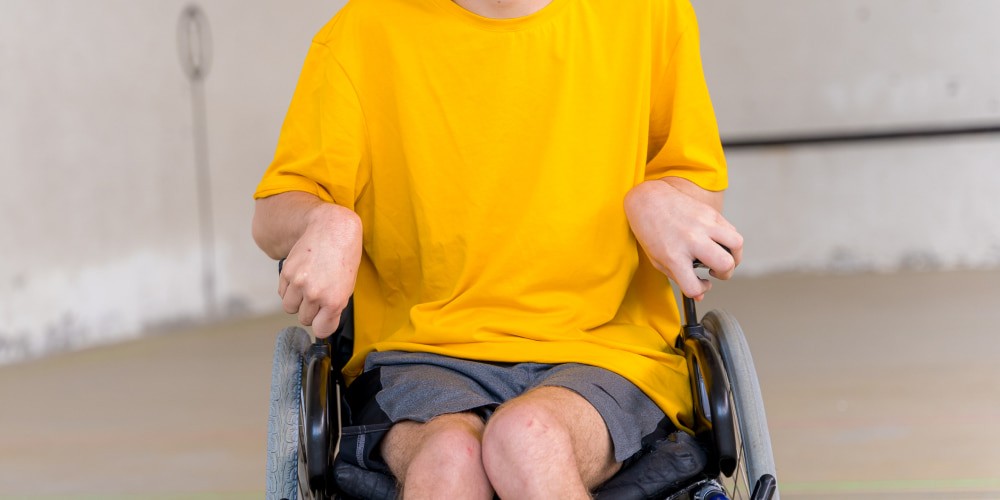Athetoid cerebral palsy is often referred to as dyskinetic cerebral palsy. It’s a subtype of cerebral palsy characterized by involuntary, uncontrolled movements. These movements primarily affect the hands, feet, and face. It makes it challenging for individuals to control their motor functions effectively. Athetoid CP is caused by damage to specific areas of the brain. They’re responsible for movement control. The condition typically occurs during pregnancy or childbirth.
The areas of the brain affected are the basal ganglia and the cerebellum. The basal ganglia is deep within the brain. It plays a crucial role in controlling voluntary motor movements. Damage to this region can lead to the erratic and uncontrollable motions seen in athetoid cerebral palsy. Also, the cerebellum can also be affected, further contributing to motor difficulties.
In this guide, we will delve into what athetoid cerebral palsy is. We will learn how to spot its symptoms and understand the distinctive athetoid movements. Also, we’ll explore treatment options, and address frequently asked questions about this condition.
Spotting Athetoid Cerebral Palsy Symptoms
In the next block, we’ll look at the symptoms of athetoid cerebral palsy. Athetoid cerebral palsy is a complex neurological condition. It comes with a wide range of symptoms. Some of which might not be immediately obvious and need careful observation. These symptoms go beyond just the unique athetoid movements. And they can include challenges related to movement, speech, thinking, and emotions.
Recognizing these symptoms early is crucial for timely diagnosis. In the next part, we’ll thoroughly examine these symptoms. We will shed light on their various forms and how they impact the lives of individuals.
Motor Function Difficulties
They’re:
- Difficulty in Holding Objects. Individuals with dyskinetic cerebral palsy may have trouble grasping and holding objects. It’s due to the constant movement in their hands.
- Imprecise Speech. Speech difficulties can arise. It’s due to the involvement of facial muscles. It makes it challenging to articulate words clearly.
- Difficulty with Fine Motor Skills. Tasks requiring fine motor skills (buttoning shirts or tying shoelaces) can be challenging.
Speech and Communication Impairments
They’re:
- Dysarthria. Dyskinetic cerebral palsy can lead to dysarthria. It’s a condition characterized by difficulty in controlling the muscles responsible for speech. This can result in slurred or imprecise speech. It makes it challenging for individuals to express themselves clearly.
- Difficulty with Articulation. Athetoid movements often affect the muscles involved in articulation. It causes issues with pronouncing words correctly. Individuals may struggle to form specific sounds, impacting their ability to communicate effectively.
- Limited Vocal Expression. Some individuals may have limited vocal expression as athetoid cerebral palsy symptoms. It’s due to muscle-related challenges. This can lead to reduced vocal volume or difficulty in modulating pitch and tone.
Cognitive and Learning Challenges
They’re:
- Executive Function Difficulties. Athetoid cerebral palsy can be associated with executive function challenges. It affects an individual’s ability to plan, organize, start tasks, and maintain attention.
- Learning Disabilities. Some individuals with athetoid CP may experience learning disabilities. They impact their academic progress. These challenges can need specialized educational support.
- Memory and Processing Issues. Cognitive challenges related to memory retention and information processing may be present. It makes it essential to adapt teaching and learning strategies.
Athetoid Movements Explained
Understanding athetoid movements is essential. It’s to grasp the nature of this cerebral palsy subtype. Athetoid movements are usually categorized into two primary types:
Dystonic Movements
Dystonic movements are characterized by sustained muscle contractions. It leads to abnormal postures and twisting motions. These movements can affect various parts of the body. It makes it difficult for individuals to maintain a stable position.
Dystonia can manifest differently in each individual. Some may experience dystonic movements primarily in their hands. It leads to clenched fists or twisted fingers.
Others may have dystonia affecting their legs. This causes their feet to turn inwards or outwards. These abnormal postures not only hinder mobility. But they can also result in physical discomfort and pain.
Managing dystonic movements in athetoid CP often involves a multidisciplinary approach. Physical therapy plays a crucial role in stretching and strengthening the affected muscles. It helps to ease some of the discomfort associated with dystonia. Additionally, medications such as muscle relaxants may reduce muscle contractions.
Choreic Movements
Choreic movements are rapid, jerky, and unpredictable. These movements often resemble fidgeting or restless behaviors. And they can make it challenging for individuals to control their limbs’ actions.
Chorea can affect various parts of the body. It leads to irregular and uncontrolled movements of the arms, legs, and face. These movements can be particularly frustrating for those with athetoid CP. These sudden jerks can disrupt their attempts to perform everyday tasks.
Occupational therapy is a valuable resource in addressing choreic movements. Therapists work with individuals to develop strategies for managing these rapid movements. Assistive devices, such as weighted utensils or stabilizing braces, can also help. It helps to regain control over their movements.
Treatment Options for Athetoid Cerebral Palsy
In the next part, we’ll explore a crucial aspect of managing athetoid cerebral palsy. Athetoid cerebral palsy comes with a range of challenges. It includes difficulties with movement, speech, and emotional well-being. The treatments designed to help address these challenges are diverse.
In the following section, we’ll take a closer look at these treatment options. We’ll provide insights into various approaches. For example, therapies to improve movement, strategies for better communication, and support for cognitive development.
These treatments empower individuals with athetoid CP. It helps them overcome obstacles, reach their potential, and lead fulfilling lives. We can appreciate the determination and strength of those facing athetoid cerebral palsy.
Physical Therapy
Physical therapy is one of the athetoid cerebral palsy treatments. It plays a significant role in managing athetoid CP. Therapists work with individuals to improve muscle strength, coordination, and range of motion. Exercises and stretches address specific motor function difficulties. And they reduce the impact of athetoid movements.
Besides addressing physical challenges, physical therapy can also boost self-confidence. They see improvements in their physical abilities. And they often gain a sense of achievement.
Occupational Therapy
This athetoid cerebral palsy treatment focuses on helping develop practical skills for daily living. Therapists work on activities like self-care, dressing, and using assistive devices. It’s to enhance independence.
One of the key goals of occupational therapy is to promote functional independence. This means helping individuals get the skills necessary to perform essential daily tasks on their own.
Medications
Medications may manage athetoid movements and reduce muscle spasms. These medications aim to provide relief from involuntary movements. Although they may have side effects.
Medications used as athetoid cerebral palsy treatment often include muscle relaxants and anticholinergic drugs. These medications can help ease the discomfort and frustration associated with constant movements.
Assistive Devices
Wheelchairs, communication aids, and adaptive tools can significantly improve the quality of life. These devices help compensate for motor function difficulties and enhance mobility and communication.
For individuals with severe athetoid CP, mobility can be a significant challenge. Wheelchairs, both manual and motorized, provide them with the freedom to move independently. Communication aids, such as speech-generating devices, enable individuals with speech difficulties to express themselves more effectively.
Surgical Interventions
This is athetoid cerebral palsy treatment for severe cases. It’s to address specific issues related to athetoid CP. These interventions are typically reserved for individuals with severe motor impairments or complications.
One such surgical option is deep brain stimulation (DBS). DBS involves the implantation of electrodes into specific regions of the brain. It includes the basal ganglia, which is often affected in athetoid CP. These electrodes are connected to a device similar to a pacemaker. It delivers electrical impulses to modulate brain activity. It has shown promise in reducing the severity of condition and improving quality of life.
Conclusion
Athetoid cerebral palsy is a subtype of cerebral palsy. It’s characterized by involuntary, uncontrolled movements. They primarily affect the hands, feet, and face. Early diagnosis and intervention are crucial for managing this condition effectively. With a combination of therapies, medications, assistive devices, and, in some cases, surgical interventions, individuals with athetoid CP can lead fulfilling lives and overcome many of the challenges posed by this neurological disorder.
FAQ
What causes athetoid cerebral palsy?
It’s caused by damage to specific areas of the brain responsible for motor control. This damage can occur during pregnancy, childbirth, or shortly after birth. It’s due to factors such as oxygen deprivation, infections, or genetic mutations.
Are athetoid movements always a sign of cerebral palsy?
No, athetoid movements are not always indicative of cerebral palsy. Athetoid movements are a common characteristic of athetoid cerebral palsy. But other neurological or genetic disorders can cause them. A comprehensive medical evaluation is necessary. It’s to determine the underlying cause of these movements.
How common is athetoid cerebral palsy?
Athetoid cerebral palsy is one of the less common subtypes of cerebral palsy. It’s estimated to account for around 10-20% of all cerebral palsy cases. However, the exact prevalence may vary by region and population.












Please, leave your review
Write a comment: